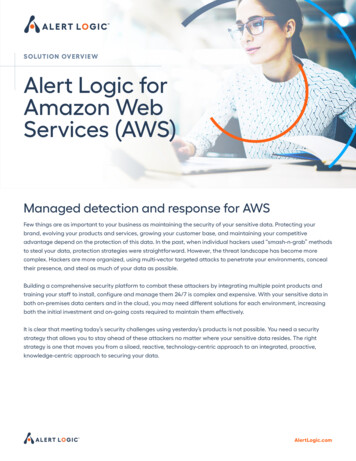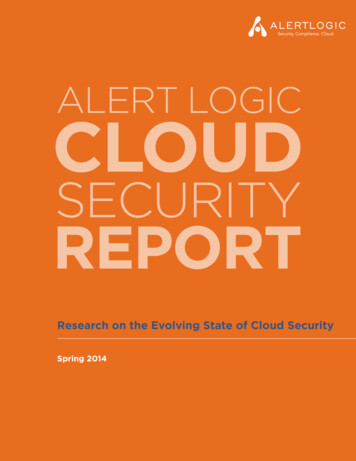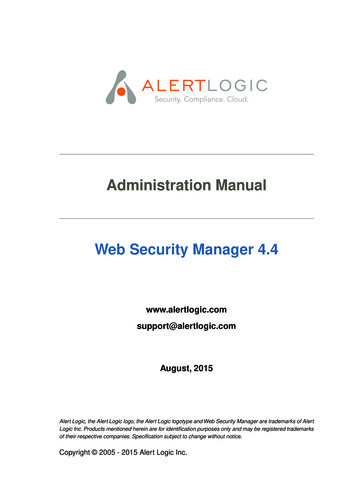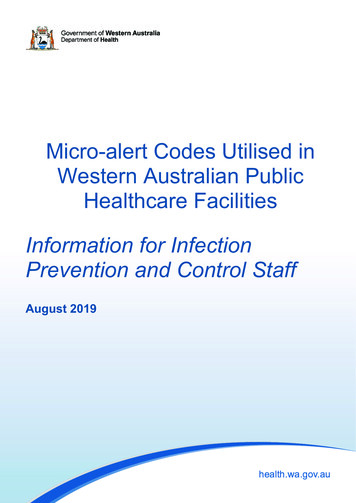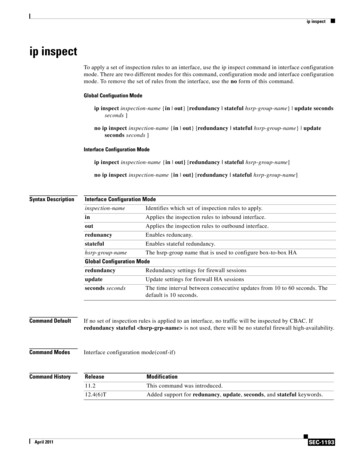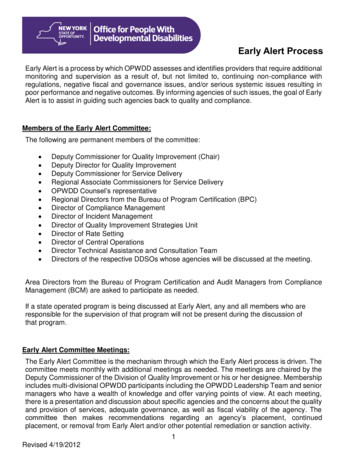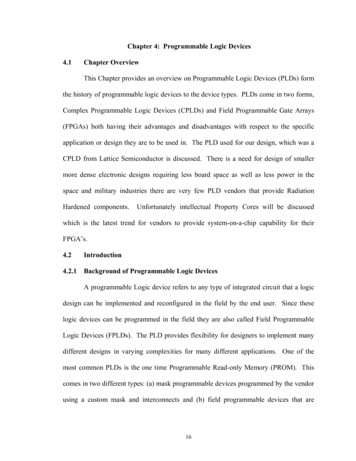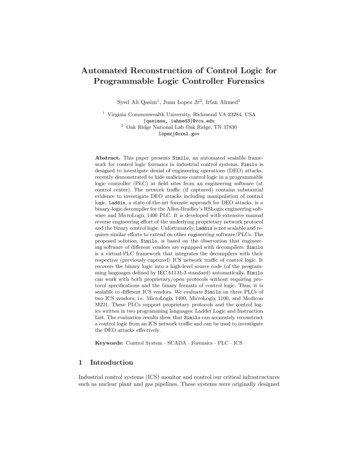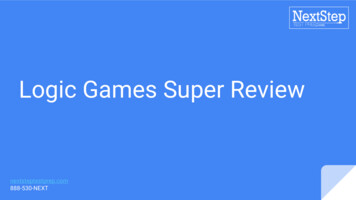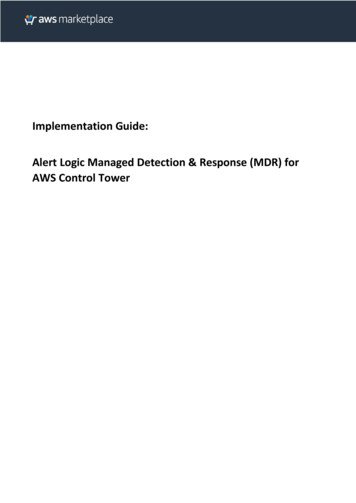
Transcription
Implementation Guide:Alert Logic Managed Detection & Response (MDR) forAWS Control Tower
Table of ContentsForeword . 3Solution overview and features . 4Architecture diagram. 5Pre-requisites . 8Deployment and Configuration Steps . 9Best Practices . 13Solution Estimated Pricing. 13FAQs. 13Additional resources. 13Partner contact information. 13Page 2 of 13
ForewordAlert Logic Managed Detection and Response (MDR) helps you identify and respond to attacks fasterthrough seamlessly connecting an award-winning security platform, cutting-edge threat intelligence, andexpert defenders.The purpose of this AWS Implementation Guide is to enable every AWS Marketplace customer to seamlesslyactivate, deploy and configure Alert Logic MDR in an AWS Control Tower environment while taking fulladvantage of the resources pre-configured by AWS Control Tower as part of the initialization.Page 3 of 13
Solution overview and featuresYour company’s security depends on being able to detect threats and respond to attacks quickly. But mostorganizations investigate less than 4 percent of all events they receive.Alert Logic has a better way. A managed connected solution that brings an award-winning platform, cutting-edge threatintelligence, and expert defenders together Flexible coverage tailored to your individual business needs 24/7 SOC and expert remediation advice Simple pricing with a lower total cost than assembling your own solutions or traditional outsourcingWith Alert Logic Managed Detection and Response (MDR), you receive: Threat detection that spans the entire attack surface and operates at scale Protection for your business - including your containers and applications - with the provencombination of a network intrusion detection system (IDS), vulnerability management, logmanagement, extended endpoint protection and web application firewall protection for hybrid,cloud, and on-premises environments Threat intelligence based on industry data and expert security analyst research, with machinelearning based on data analysis across thousands of customers’ attack surface Real-time alerting, incident verification, and remediation guidance from experts available 24/7with a 15-minute SLA for verified incidents Alert Logic MDR’s integration with AWS Control Tower enables customers to automatically protect existingand newly enrolled AWS Accounts through a series of automations in response to an AWS Control TowerLifeCycle events: Perform pre-requisite steps to setup Alert Logic MDR in the AWS account vended by AWS ControlTower Account Factory Register AWS account in Alert Logic MDR portal to initiate asset discovery and security assessment. Set up ingestion of AWS CloudTrail logs into Alert Logic MDR platform. Tag Amazon VPCs with Alert Logic identifiers in all AWS accounts so that they are included in theprotection scope by Alert Logic MDR. Deploy Alert Logic MDR scanning and intrusion detection system (IDS) appliances to the target VPCsbased on the protection scope.Page 4 of 13
Architecture diagramAlert Logic MDR’s AWS Control Tower Automation utilizes the following AWS Services to enable automaticprotection of existing or newly enrolled AWS Accounts: Amazon EventBridge, AWS CloudFormation, AWSLambda, AWS IAM, AWS Secrets Manager, Amazon SNS and Amazon SQSAWS Accounts presented in the architecture diagram Control Tower Master Account – Master account on which AWS Control Tower was enabled Log Archive Account – Account for centralized repository of logs including CloudTrail logs. Audit Account – Restricted account with read/write access to all accounts. Centralized SNS topic forsecurity and CloudTrail notification are located here. Security Account – An account where Alert Logic Control Tower Automation Orchestration isdeployed.Page 5 of 13
Linked Account – One or more AWS Accounts protected by Alert Logic MDR. This is the accountwhich Alert Logic Appliances and Agents are deployed into.Overview of the SolutionThe following steps are associated with numbers 1-6 indicated in the architecture diagram.1. When a new Linked account is enrolled into AWS Control Tower, the LifeCycle lambda functionreceives a notification from AWS Control Tower and deploys AlertLogic-CT StackSet Instance to thenew Linked account.2. In the new Linked account, AlertLogic-CT StackSet Instance will create an IAM Role to enableAlert Logic MDR Asset Discovery. Upon completion, the stackset instance send SNS event via CustomResource to the Security account to nofity that a new deployment must be registered with AlertLogic MDR.3. In the security account, a lambda function named Register is subscribed to the ALHubTopic SNStopic to receive new deployment registration requests from the new Linked account. Once itreceives a notification request, it registers a new linked account deployment with Alert Logic MDR.4. When user in the new Linked account tagged/untagged any VPCs with any of the following keys:"al", "alertlogic", "tm", "threatmanager", an event is published to Amazon EventBridge.5. Lambda function named Deploy receives the event and updates deployment protection scope inAlert Logic MDR accordingly.6. If ‘Automatic’ mode was specified during the initial setup, Alert Logic will create a security subnet ina newly protected VPC and deploy Alert Logic appliances. If ‘Manual’ mode was chosen, it is aresponsibility of a customer to deploy Alert Logic Appliances to protect newly added VPCs. AlertLogic MDR supports two deployment mode: yment-types.htm#DeploymenttypesThe deployment of this solution begin with a CloudFormation stack deployed in the AWS Control TowerMaster account. The stack creates 2 AWS Lambda Functions, 2 AWS CloudFormation StackSets and AWSCloudWatch Event Rule for AWS Control Tower Lifecycle. Onboarding Lambda are used during initialdeployment to orchestrate AlertLogic-CT StackSets instance, creation of SQS in Log archive account andSQS to SNS subscription in Audit account. Onboarding Lambda also orchestrate AlertLogic-CTCentral-IAM-Role stackset (not shown in the diagram) to create a stackset instance in Log Archiveaccount for CloudTrail ingestion. Lifecycle Lambda will be triggered by the CloudWatch Event Rule duringnew AWS account setup, this Lambda will deploy AlertLogic-CT StackSets to the new AWS account.Page 6 of 13
AlertLogic-CT stackset launches stackset instances in all AWS accounts included in the scope ofdeployment. In each accounts, this stackset creates an IAM role for Alert Logic MDR and CloudWatch Eventrule for detecting tag changes on VPC. AlertLogic-CT stackset create additional resource in the SecurityAccount including: an Amazon SNS Topic, 2 AWS Lambda Functions, and an Amazon EventBridge Event bus.Page 7 of 13
Pre-requisitesThe solution doesn’t require any additional resources to be enabled outside of the ones already enabled byAWS Control Tower. This guide assume you already have AWS Control Tower deployed. To get started withAWS Control Tower, check out the Getting Started documentation.The solution requires a dedicated AWS account to be designated as Security account. The Security accountmust be part of AWS Control Tower managed account.Before you implement this solution, we recommend that you become familiar with AWS CloudFormation,AWS Lambda, AWS CloudTrail and Amazon EventBridge services.In addition, it is unlikely that a customer will need to increase any limits, but it is important to note that theAutomation solution will create an EventBridge in the Security Account to capture tags updates in LinkedAccounts.If you are new to AWS, see Getting Started with AWS: https://aws.amazon.com/getting-started/.For additional information on AWS Marketplace, see age 8 of 13
Deployment and Configuration StepsStep 1.1: Subscribe to Alert Logic MDR products on AWS Marketplace.Locate the Alert Logic MDR in the AWS Marketplace Alert Logic MDR (US) Alert Logic MDR (UK) Alert Logic MDR Professional - SaaS Contract (US) Alert Logic MDR Professional - SaaS Contract (UK)Click on the Continue to Subscribe button.Page 9 of 13
Step 1.2: Guidance on Contract Duration and RenewalIn the new screen, you can configure your contract. You can select the Contract Duration and set theRenewal Settings.Step 1.3: Select Contract OptionsSelect the Contract Options to be activated with your contract.Page 10 of 13
Step 1.4: Create the Contract and PayOnce you have configured your contract, you can click on the Create contract button.You will be prompted to confirm the contract. If you agree to the pricing, select the Pay Now button.Step 1.5: Set up AccountOnce you subscribed to the solution, Alert Logic sends email validation email. Once confirmed, another emailis sent to enable password reset and the access to the portal is granted.Step 2.1: Log into Alert Logic MDRGo to https://console.account.alertlogic.com/#/login to login to Alert Logic portal.Step 2.2: Getting StartedCreate API Keys to enable Automation Solution deployment. In order to do that, go to ‘Manage- Users’section in the Alert Logic Portal, select existing or create new user and generate new access key id/secret inthe user’s Access Keys section.Save access key id and the secret as you will need this information in order to deploy Alert Logic MDRAutomation for AWS Control Tower.For more detail, follow the user guide: gement.htm#GenerateanaccesskeyStep 3.1: Deploy Solution in Master AccountLogin in to Master account in AWS Control Tower as an Administrator. To deploy solution, select the regionwhere your AWS Control Tower is deployed, create new CloudFormation Stack using template lYou will need to provide the following information in order to deploy CloudFormation Stack: Alert Logic Customer ID – This can be found on the Support page in Alert Logic Portal Alert Logic API Access Key and Alert Logic API Secret generated in step 2.2. AlertLogic Deployment Mode – Choose ‘Automatic’ if you want enable Alert Logic to automaticallydeploy Alert Logic MDR appliances into protected VPCs. Otherwise, select ‘Manual’ to assumeresponsibility of deploying Alert Logic Appliances. AWS Account ID to deploy Alert Logic’s AWS Control Tower automation (Security Account) –Designated AWS security accountPage 11 of 13
Organizational Units to protect – Comma-delimited list of Organizational Units to enable Alert LogicMDR Automation for. Leave the default (ALL) to enable Automation for all Organizational units. Organizational Units to exclude from protection – Comma-delimited list of Organizational Units toexclude from Automation. TargetRegion – Comma-delimited list of regions to enable Alert Logic MDR Automation for. Protect All VPCs in each region – set to True if you want to include all VPCs, set to False if you wantto use VPC tags to select the scope. VPC Tags to protect – Comma delimited list of key-value pair of tags for protection scope. Organization ID – AWS Organization ID Log Archive Account ID – AWS Control Tower Log Archive account Audit Account ID – AWS Control Tower Audit accountLeave the remaining parameters as default and then launch the stack.Step 3.3: Verification StepsUpon Cloud Formation deployment completion, you should see Shared accounts listed as deployments inAlert Logic MDR portal.Any Stack Instances with status shown as CURRENT in AlertLogic-CT CloudFormation StackSet will be listed asdeployments in Alert Logic MDR portalStep 4.1: Validation StepsIf deployment mode is set to Automatic and Protect all VPCs is set to True, Linked Accounts will have AlertLogic appliance automatically deployed within 15 minutes.In addition, it is customer’s responsibility to install Alert Logic MDR Agents to protected hosts. Follow theseinstructions to deploy Alert Logic MDR Agents: lert-logic-agent-windows.htmThe agents will be automatically claimed and assigned to the appliances.Step 4.2: How to useAlert Logic MDR solution will automatically analyze network traffic, logs (CloudTrail and host logs) and scanhosts for vulnerabilities. This information can be accessed through the Alert Logic MDR Portal. Please refer toFAQ and Additional Resource sections below for more detail.Page 12 of 13
Best Practices AWS Cross Account Role Setup for Alert Logic MDR: nt-role-setup.htm Alert Logic MDR Deployment Types: oymenttypes.htm Configure IAM Role for AWS: ion.htm Create and Manage Alert Logic Access Keys: gement.htmSolution Estimated PricingPricing detail is available on AWS Marketplace: QsFAQ: /115001241223-Frequently-Asked-QuestionsAdditional resources ons-addons.htm .htm esponse/ for-amazon-web-services-aws/ ving-the-way-to-the-Cloud-20.pdf ilt-for-AWS.pdfPartner contact e 13 of 13
Set up ingestion of AWS CloudTrail logs into Alert Logic MDR platform. Tag Amazon VPCs with Alert Logic identifiers in all AWS accounts so that they are included in the protection scope by Alert Logic MDR. Deploy Alert Logic MDR scanning and intrusion detection system (IDS) appliances to the target VPCs based on the protection scope.
